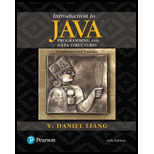
Introduction to Java Programming and Data Structures, Comprehensive Version Plus MyProgrammingLab with Pearson EText -- Access Card Package
11th Edition
ISBN: 9780134694511
Author: Liang, Y. Daniel
Publisher: Pearson Education Canada
expand_more
expand_more
format_list_bulleted
Question
Chapter 23, Problem 23.13PE
Program Plan Intro
Execution time for sorting
Program Plan:
- Import the required packages.
- Create a class “Sorting”:
- Define the main method
- Loop that iterates to display the execution time of the various sorting
algorithms. - Display the values.
- Loop that iterates to display the execution time of the various sorting
- Define the method “dispval()”
- Define the required variables.
- New list gets created.
- Loop that iterates for creating a random numbers.
- Define the formatting options.
- Perform various sorting operations and display the time calculated.
- Display the time after performing operations.
- Define the method to perform “selectionsort()”
- Define the method to perform “Bubble sort()”
- Define the method to perform “Merge sort()”
- Define the method to perform “quicksort()”
- Define the method to perform “radixsort()”
- Define the main method
Expert Solution & Answer
Want to see the full answer?
Check out a sample textbook solution
Students have asked these similar questions
Write the SQL code that permits to implement the tables: Student and Transcript. NB: Add the constraints on the attributes – keys and other.
Draw an ERD that will involve the entity types: Professor, Student, Department and Course. Be sure to add relationship types, key attributes, attributes and multiplicity on the ERD.
Draw an ERD that represents a book in a library system. Be sure to add relationship types, key attributes, attributes and multiplicity on the ERD.
Chapter 23 Solutions
Introduction to Java Programming and Data Structures, Comprehensive Version Plus MyProgrammingLab with Pearson EText -- Access Card Package
Ch. 23.2 - Prob. 23.2.1CPCh. 23.2 - Prob. 23.2.2CPCh. 23.2 - Prob. 23.2.3CPCh. 23.3 - Prob. 23.3.1CPCh. 23.3 - Prob. 23.3.2CPCh. 23.3 - Prob. 23.3.3CPCh. 23.4 - Prob. 23.4.1CPCh. 23.4 - Prob. 23.4.2CPCh. 23.4 - What is wrong if lines 615 in Listing 23.6,...Ch. 23.5 - Prob. 23.5.1CP
Ch. 23.5 - Prob. 23.5.2CPCh. 23.5 - Prob. 23.5.3CPCh. 23.5 - Prob. 23.5.4CPCh. 23.6 - Prob. 23.6.1CPCh. 23.6 - Prob. 23.6.2CPCh. 23.6 - Prob. 23.6.3CPCh. 23.6 - Prob. 23.6.4CPCh. 23.6 - Prob. 23.6.5CPCh. 23.6 - Prob. 23.6.6CPCh. 23.6 - Prob. 23.6.7CPCh. 23.6 - Prob. 23.6.8CPCh. 23.6 - Prob. 23.6.9CPCh. 23.7 - Prob. 23.7.1CPCh. 23.7 - Prob. 23.7.2CPCh. 23.8 - Prob. 23.8.1CPCh. 23 - Prob. 23.1PECh. 23 - Prob. 23.2PECh. 23 - Prob. 23.3PECh. 23 - (Improve quick sort) The quick-sort algorithm...Ch. 23 - (Check order) Write the following overloaded...Ch. 23 - Prob. 23.7PECh. 23 - Prob. 23.8PECh. 23 - Prob. 23.10PECh. 23 - Prob. 23.11PECh. 23 - Prob. 23.12PECh. 23 - Prob. 23.13PECh. 23 - (Selection-sort animation) Write a program that...Ch. 23 - (Bubble-sort animation) Write a program that...Ch. 23 - (Radix-sort animation) Write a program that...Ch. 23 - (Merge animation) Write a program that animates...Ch. 23 - (Quicksort partition animation) Write a program...Ch. 23 - (Modify merge sort) Rewrite the mergeSort method...
Knowledge Booster
Similar questions
- 2:21 m Ο 21% AlmaNet WE ARE HIRING Experienced Freshers Salesforce Platform Developer APPLY NOW SEND YOUR CV: Email: hr.almanet@gmail.com Contact: +91 6264643660 Visit: www.almanet.in Locations: India, USA, UK, Vietnam (Remote & Hybrid Options Available)arrow_forwardProvide a detailed explanation of the architecture on the diagramarrow_forwardhello please explain the architecture in the diagram below. thanks youarrow_forward
- Complete the JavaScript function addPixels () to calculate the sum of pixelAmount and the given element's cssProperty value, and return the new "px" value. Ex: If helloElem's width is 150px, then calling addPixels (hello Elem, "width", 50) should return 150px + 50px = "200px". SHOW EXPECTED HTML JavaScript 1 function addPixels (element, cssProperty, pixelAmount) { 2 3 /* Your solution goes here *1 4 } 5 6 const helloElem = document.querySelector("# helloMessage"); 7 const newVal = addPixels (helloElem, "width", 50); 8 helloElem.style.setProperty("width", newVal); [arrow_forwardSolve in MATLABarrow_forwardHello please look at the attached picture. I need an detailed explanation of the architecturearrow_forward
- Information Security Risk and Vulnerability Assessment 1- Which TCP/IP protocol is used to convert the IP address to the Mac address? Explain 2-What popular switch feature allows you to create communication boundaries between systems connected to the switch3- what types of vulnerability directly related to the programmer of the software?4- Who ensures the entity implements appropriate security controls to protect an asset? Please do not use AI and add refrencearrow_forwardFind the voltage V0 across the 4K resistor using the mesh method or nodal analysis. Note: I have already simulated it and the value it should give is -1.714Varrow_forwardResolver por superposicionarrow_forward
- Describe three (3) Multiplexing techniques common for fiber optic linksarrow_forwardCould you help me to know features of the following concepts: - commercial CA - memory integrity - WMI filterarrow_forwardBriefly describe the issues involved in using ATM technology in Local Area Networksarrow_forward
arrow_back_ios
SEE MORE QUESTIONS
arrow_forward_ios
Recommended textbooks for you
 C++ for Engineers and ScientistsComputer ScienceISBN:9781133187844Author:Bronson, Gary J.Publisher:Course Technology Ptr
C++ for Engineers and ScientistsComputer ScienceISBN:9781133187844Author:Bronson, Gary J.Publisher:Course Technology Ptr C++ Programming: From Problem Analysis to Program...Computer ScienceISBN:9781337102087Author:D. S. MalikPublisher:Cengage Learning
C++ Programming: From Problem Analysis to Program...Computer ScienceISBN:9781337102087Author:D. S. MalikPublisher:Cengage Learning Systems ArchitectureComputer ScienceISBN:9781305080195Author:Stephen D. BurdPublisher:Cengage Learning
Systems ArchitectureComputer ScienceISBN:9781305080195Author:Stephen D. BurdPublisher:Cengage Learning- Programming Logic & Design ComprehensiveComputer ScienceISBN:9781337669405Author:FARRELLPublisher:Cengage
 Programming with Microsoft Visual Basic 2017Computer ScienceISBN:9781337102124Author:Diane ZakPublisher:Cengage Learning
Programming with Microsoft Visual Basic 2017Computer ScienceISBN:9781337102124Author:Diane ZakPublisher:Cengage Learning Microsoft Visual C#Computer ScienceISBN:9781337102100Author:Joyce, Farrell.Publisher:Cengage Learning,
Microsoft Visual C#Computer ScienceISBN:9781337102100Author:Joyce, Farrell.Publisher:Cengage Learning,

C++ for Engineers and Scientists
Computer Science
ISBN:9781133187844
Author:Bronson, Gary J.
Publisher:Course Technology Ptr

C++ Programming: From Problem Analysis to Program...
Computer Science
ISBN:9781337102087
Author:D. S. Malik
Publisher:Cengage Learning

Systems Architecture
Computer Science
ISBN:9781305080195
Author:Stephen D. Burd
Publisher:Cengage Learning

Programming Logic & Design Comprehensive
Computer Science
ISBN:9781337669405
Author:FARRELL
Publisher:Cengage

Programming with Microsoft Visual Basic 2017
Computer Science
ISBN:9781337102124
Author:Diane Zak
Publisher:Cengage Learning

Microsoft Visual C#
Computer Science
ISBN:9781337102100
Author:Joyce, Farrell.
Publisher:Cengage Learning,